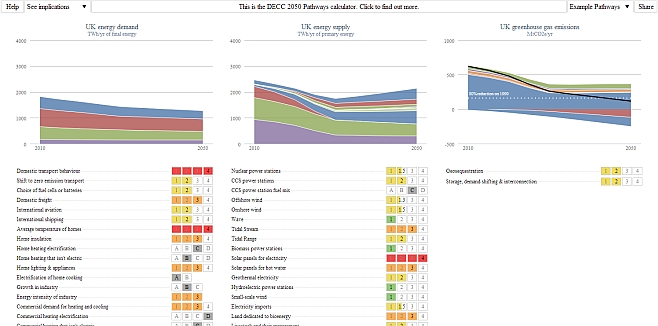Dear all,
First of all: sorry for the long posting silence. I could give you a long list of excuses, but I am not going to. I'm back! Today's topic: not directly related to the cold, nor to climate science per se. But on the most important climate change mitigation issue: energy. Demand, supply and storage: the 2050 pathways discussed by a group of experts (and some semi-knowledgeable-lucky-to-be-there people like myself).
Yesterday, I had one of these moments every scientist needs once in a while. The realisation: "Yes, this is why I want to be a part of the scientific community. This is what I am set out to do with my life."
Why this moment happened? Because I got to attend the Institution of Engineering and Technology Clerk Maxwell lecture at the beautiful venue of the Royal Institution of Great Britain. There I was: alone, intimidated and about 30 years younger than the average participant.
The speaker for this event was David J.C. MacKay, chief scientific advisor to the Department of Energy and Climate Change and Regius Professor in Engineering at the University of Cambridge.
His book "Sustainable Energy Without the Hot Air" I consider to be the best book on the topic of renewable energy, because it quantifies the issues at hand, rather than using lengthy and empty 'green lobby' explanations. As the book's motto says: "Numbers, not Adjectives." It is freely available for you to download as a PDF
here, which I highly recommend you do. This book is also one of the reasons I got into climate science in the first place, so I was excited to hear David MacKay speak.
The lecture was centred around the 2050 Energy Pathways, meaning the way we will have to change our energy use and supply if the UK wants to reach its target of an 80% reduction in CO2 emission, from the 1990 baseline (
DECC). In order to simulate several ways to reach these targets, the UK 2050 Calculator was developed. It is a tool that, as MacKay says, "Allows you to be the secretary of state or dictator of Britain for a bit." It is pretty self-explanatory, so have a look and play around with it
HERE before you read the rest of this post.
This is what the pathway calculator looks like. Source
MacKay started out with a brief explanation on climate science, being especially clear that natural variability occurs, the current hiatus is statistically meaningless and surface temperature is the most useful indicator of global warming. He did not dwell on the topic for long, because he (rightly) assumed that the crowd agreed climate change is a global challenge that needs to be addressed.
The next hour was devoted to constructing an "IET Pathway", involving discussion within the room and for each lever choosing the levels we thought desirable and realistic. Especially high-impact levers are e.g. thermostat setting and the choice for or against nuclear power.
However, by the end of the lecture - by no means end of the discussion, but we ran out of time - we did not succeed in reaching the target of an 80% emission reduction. This, to me, is worrying for mainly these two reasons:
1) The majority of participants lasts night were engineers and scientists with the 'prerequisites' that they understand the threat climate change poses, understand energy demand and supply, and most importantly understand the importance of immediate action. They applied their expertise with the full intention of reaching the target, and through majority voting we reached answers that quite fairly represented the ideas of the crowd.
If this group could not even reach the target, factor in Britain's real life population. This population includes many that either don't understand the topic, do not care about it, or do not care enough to change their behaviour - all three necessary in order to actually succeed. Then there are the ones that understand, but value their personal short-term (ie. human life span) gain over future populations' problems. Considering the behavioural changes that would have to be made within the majority of British homes - thermostat down to 18C, extra insulation, taking the train instead of the BMW - and the likely protest against them, I am pessimistic.
2) In our "let's-make-Britain-better" discussion we did not consider policy implementation problems or cost. Our big plans for nuclear power for example - I'm all for it - are highly difficult in terms of politics. Thank goodness we don't have an Angela Merkel size problem here, but still, substantial trouble could stand in the way of building ca. 65 GW capacity worth of new nuclear power stations.
Second, the costs of covering every single south-facing roof in Britain? Building new railway tracks because train travel needs to increase by 115%? Changing the infrastructure of every major city in Britain because we need a 10-fold (!) increase in cycling? (For all you pro-London-cycling: no, it is not safe enough yet. Nope. No way.) These are immense costs we're looking at.
Cost is a part of the calculator you can play around with, which I will definitely do, but was not part of our discussion.
In conclusion, I want to emphasize that regardless of how unlikely it is that the entire British population would want to work with our decisions, political issues and huge attached costs, we initially did not reach the target. We did finally reach the goal through MacKay deciding we would all just be a little more ambitious in terms of shipping, aviation and electricity storage. Our final IET Lecture Patyway you can find
HERE.
The lecture was inspiring, it re-confirmed my determination to become a scientist, yet it also left me with a reality check once again of how incredibly difficult the task ahead of us is.
For now: please play around with the calculator and share your results with me. Also have a look at David MacKay's own blogpost on the evening, right
here.












